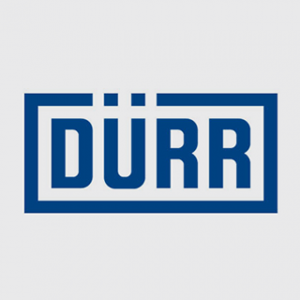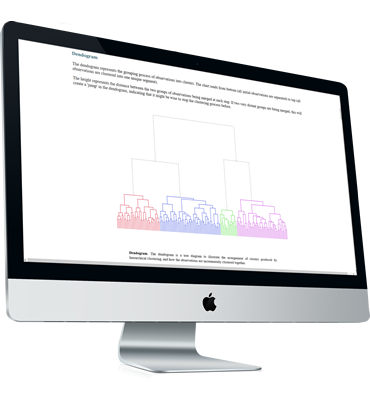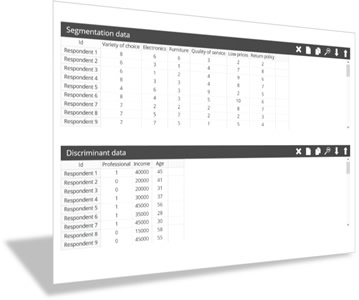
Dürr Environmental case study (segmentation, conjoint)
Dürr Environmental (segmentation, conjoint) Try it! In early 2007, Dürr Environmental Controls, a German conglomerate with capabilities in this arena and extensive industrial operations in

Segmentation helps firms to segment customers in a market. Enginius classifies customers into homogeneous groups such that each segment shares enough characteristics in common to make it viable for the firm to design specific offerings or products for selected segments. Enginius can segment customers based on past behavior, responses to surveys, etc., to identify groups of customers with specific needs, profiles or preferences.

The segmentation model has many features to help you better visualize your data, such as colorized dendrograms, screeplots, visual segment description, segmentation space, etc.

Selecting the right number of segments to summarize your data is as much an art as it is a science: it needs to be managerially relevant; it ideally should lead to targetable segments with clear discriminating descriptors; and the segment solution needs to be statistically sound. As a first step, Enginius can analyze the dendrogram and suggest a segment solution automatically.

Segmentation data can be skewed, scattered, or collected using different scales. Enginius allows you to standardize or scale the data automatically using various techniques, such as standardization (if the data has been collected on different scales), normalization (if the data is skewed), or factorization (to pre-remove noise from the data).

Using the same visualization tools as in positioning analysis, Enginius displays the segmentation space graphically, allowing you to visualize which segmentation variables tend to move hand in hand, which tends to move in opposite directions, and where segments are positioned in that space.

Besides the segmentation data used to segment your customers, you might have descriptors available to describe them, such as age, gender, profession, or media usage. Enginius can try to identify whether these descriptors alone could predict to which segments your target customers belong, and if conclusive, it can apply that discriminant model to classify a new list of contacts into their most likely segments, only based on their available descriptors. And if your descriptors are not numeric (e.g., “male”, “female”), don’t worry, you don’t need to transform them into 0’s and 1’s. Enginius will transform your data automatically into an acceptable format.

Dürr Environmental (segmentation, conjoint) Try it! In early 2007, Dürr Environmental Controls, a German conglomerate with capabilities in this arena and extensive industrial operations in

Kirin is a robust case involving multiple models. Kirin (a Japanese beer producer) is faced with expanding US sales where a competitor (Sapporo) outsells them. Kirin is contemplating introducing new products to boost sales but must determine 1) the target markets and 2) the product attributes that will appeal to each market segment.

ConneCtor PDA (segmentation) Try it! The case presents a standard segmentation and targeting challenge facing Netlink in the early days of the smart phone market.

ISBM (segmentation, positioning) Try it! The ISBM is a non-profit global network of researchers and practitioners headquartered at Pennsylvania State University, largely supported by corporate

Forte Hotel (conjoint, segmentation) Try it! Forte hotel uses the Conjoint and Segmentation models to analyze customers’ preferences across a number of attributes under consideration

Pacific Brands (segmentation) Try it! Pacific Brand Limited (an Australian lingerie manufacturer) is facing a new “normal” of a slow, extended period of economic recovery.

FLIP Side of Segmentation (segmentation) Try it! FLIP (www.learnwithflip.com) was incorporated with a vision of becoming India’s largest e-training and certification organization in the banking